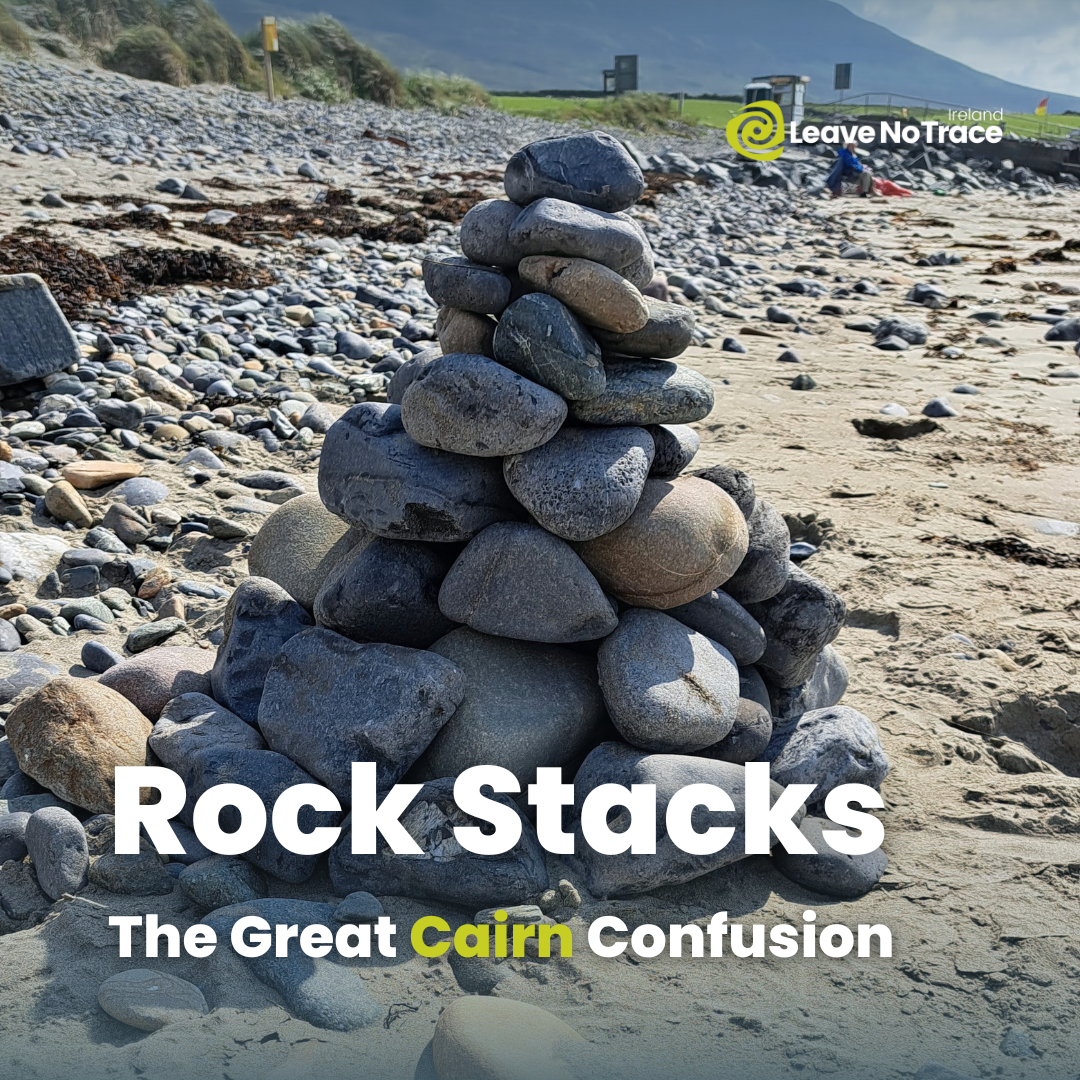Each week, we will share a #SimpleAction that you can do to help protect Ireland’s biodiversity, cultural heritage and wildlife.
Rocks Stacks: The Great Cairn Confusion
In recent years, there has been a rise in the trend of building rock stacks or “cairns”. But quite simply… Rock Stacks are not cool!
What is a “cairn” and what is a “rock stack”? Although they look the same, but their purpose is different.
Cairn:
The word “cairn” has its origins from Scots Gaelic. Historically, cairns can be dated back as far as the Bronze Age, and were used as a burial marker or memorial site to honour the dead. They were also seen as portals to the Otherworld (spooky!). They were frequently used by our Gaelic ancestors and are an important part of our island’s heritage.
Cairns were also adopted as a natural solution to way-mark trails in upland areas, and can help hillwalkers to safely navigate through hills and mountains.

(Example of trail cairn in Scotland).
Rock Stack:
Rock Stacks have become increasingly popular on social media in recent years, with people adding a rock when they visit a scenic place. These stacks are what we call a “beacon impact” – once someone starts a rock stack, more will begin to appear. And after a while, they begin to completely take over the landscape, like rock gremlins!


(Rock stacks on the Cliff of Moher)
Here are 5 reasons why we don’t recommend building/adding to rock stacks:
- Firstly, we always say “Leave What You Find”. You should always leave the outdoors as you found it and leave no trace that you were ever there. Take only photos, leave only footprints. The scenery in Ireland is stunning as it is.
- Rocks can be habitats! There’s a whole world of bugs, animals and marine life depending on rocks for shelter. Rocks can also balance the pH level of the soil and provide minerals to the eco-system. So by leaving rocks where you found them, and not adding them to rock stacks, you are helping biodiversity.
- As cairns are often used for navigation, and building rock-stacks could cause people to get lost in the hills and mountains. So if you see cairns/rock stacks in the mountains, don’t add to them, leave them as they are.
- Cairns built for navigation have been carefully constructed, and adding rocks to them can make them unstable. Rock stacks built by visitors can be very unstable too. If these fall over, they could cause injury to climbers, children or animals passing by.
- From our own experience, it’s becoming increasingly difficult to tell what’s a cairn, and what a rock stack! Embrace our cultural heritage by letting our historical cairns shine through. Let us see the cairns that mark the grave of Meabh the Queen of Connacht or the legendary Fionn Mac Cumhaill. And let’s be honest… nobody really wants to see a rock stack built by Ken* and Barbie* last Sunday (*hypothetical names – no offence intended to all the Kens or Barbies who Leave No Trace).
Simple Actions that you can do to protect our environmental from Rock Stacks:
- If you are sure this is a rock stack, and not a cairn (it’s in a random location, it’s usually one rock on top of another getting thinner as it gets higher, and doesn’t appear historic or for navigation), you can help remove this beacon impact!
- In a sensitive habitat (like wetlands, peatlands or sand dunes) carefully break the stack down and disperse the rocks into a rocky area in the surrounding environment. Leave rocks that are too heavy – always mind your back!
- In a rocky habitat – knock it down! Make sure the area is clear of people and animals first, then using the heel of your foot, push the stack over. This is as “rock and roll” as it gets in the outdoors (we love a “Dad-joke”). Mind your toes and enjoy the crash!
- If you’re not sure this is a rock stack or a cairn (in uplands and forest in particular)
- Follow the Principle Leave What You Find. Don’t risk destroying the work of others or our cultural heritage.

